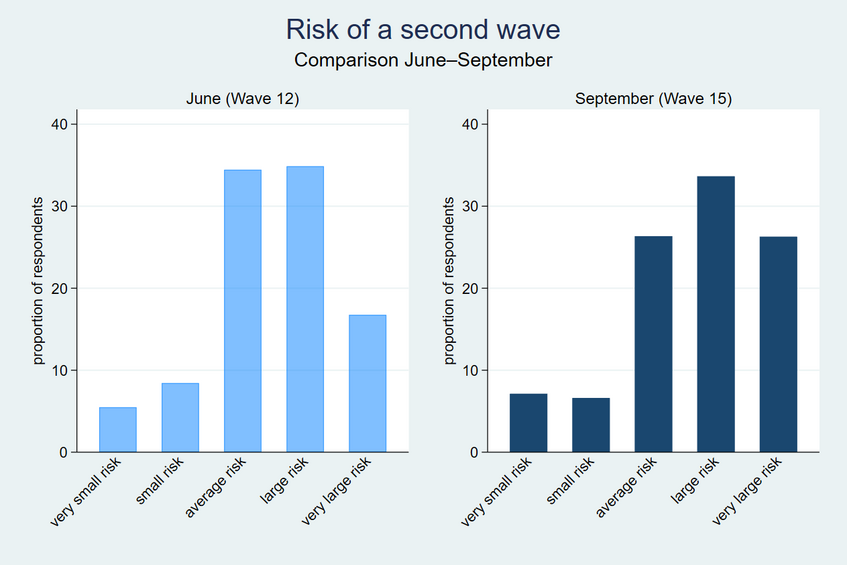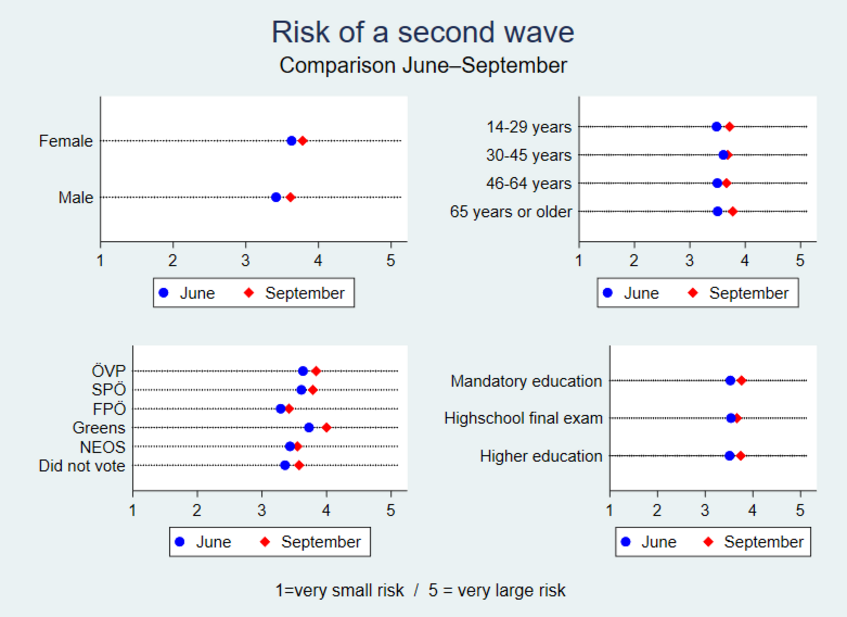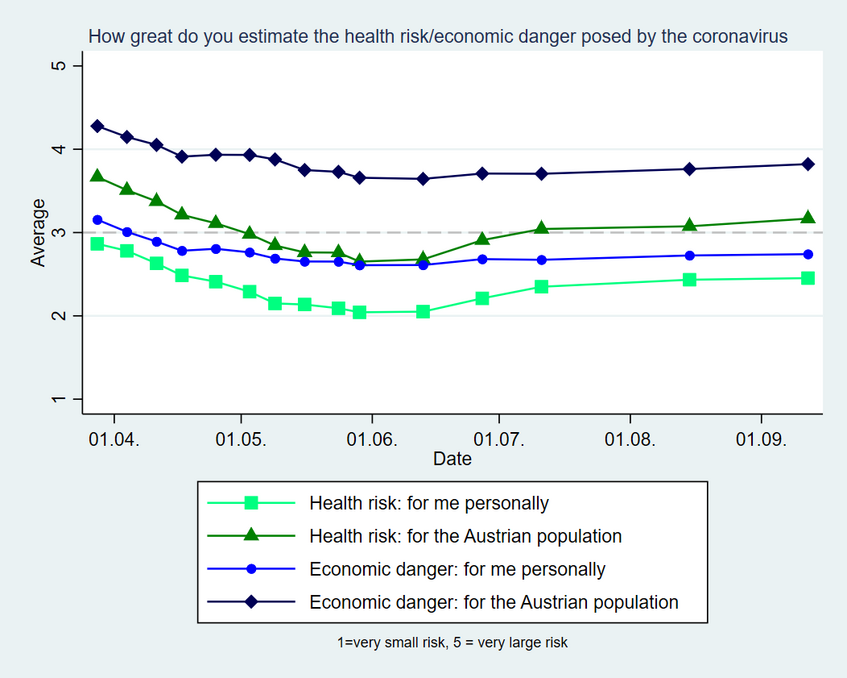23.09.2020
Who is afraid of a second wave? Risk and danger perception during the Corona crisis
- A majority of Austrians (60%) estimate the risk of a second wave as large or very large. Only 14% perceive a small risk of a second wave.
- The perceived risk of a second wave has increased during the summer in all analysed groups, especially among people that are older than 65 years. Green party voters and women perceive a possible second wave on average as a greater risk, while FPÖ voters regard the risk as smaller.
- In June, the health risk perception (personal and for the Austrian population) posed by the Coronavirus increased for the first time since the beginning of the survey during the lockdown in March and April 2020 and has been rising since.
- The assessment of the economic danger posed by the Coronavirus has decreased since the lockdown, but in contrast to the health risk perception, there has not been a new significant increase so far.
In mid-September 2020, Austrian Chancellor Sebastian Kurz announced the start of the fiercely debated second wave. While the danger of a second wave has been intensively discussed in recent days, the perception of the danger of the crisis has developed dynamically over the past months. Especially at the beginning of the crisis in Austria, the coronavirus was seen as a major health risk and as an economic danger (see blog 1).
When a situation is widely regarded as a danger to society or the state, political scientists often refer to the concept of "Securitization". The perception of an acute threat to health security can have significant effects on the political importance of the policy issue in question, on compliance with government measures and on the intensity of the measures adopted. Research results from social psychology also show that fear as a result of insecurity enhances the search for new information and the openness to change of opinion. Moreover, fear also reinforces risk-minimizing behavior. Therefore, the perception of risk and danger is an important factor both for individual behaviour during the crisis (e.g. compliance) and for the decisions of political actors.
In this blog post, the current risk assessment of a second wave as well as the perception of the general health risk and economic danger in the corona crisis over time will be presented.
Risk of a second wave
In September, the risk of a second wave was perceived as high or very high by a majority of people in Austria (60%). 26% saw an average risk of a second wave and only 14% estimated the risk of a second wave as small or very small (see Figure 1). While 52% saw a very high or high risk of a second wave in June, the proportion has increased significantly (by 8%) as Austria witnessed rising infection rates since August. It is striking, however, that the proportion of people who saw a "very great" risk increased by 10%. This very high risk perception thus affects now more than one in four respondents in Austria (26%).
When comparing the weighted mean values of risk perception of different groups at two points in time (end of June [wave 12] and mid-September [wave 15]), it is notable that there are mostly no major differences in risk assessment. (see Figure 2) Women estimate the risk of a second wave on average slightly higher than men. Furthermore, Green party voters assume a higher risk of a second wave than voters from other parties. Since voters of the ÖVP have also indicated a high risk perception, it is remarkable that voters of the governing parties perceive, on average, a higher risk of a second wave compared to the opposition parties. Voters of the FPÖ see a smaller risk on average compared to all other parties.
Different age groups assess the risk of a second wave to be similarly high, although the perception of risk among people over 65 years of age (people in the risk group) and among young people (14-29) increased significantly over the summer. Educational differences alone do not explain differences in the assessment of the risk of a second wave.
Health risk and economic danger over time
Since the Austrian Corona Panel Project started at the end of March, the perception of the health risk and economic danger has been measured. First the "health risk for me personally" and then the "health risk for the Austrian population" were asked for. In addition to the health risk, the perception of the economic danger was also measured at both levels, which takes into account the socio-economic and macroeconomic risks and problems of the crisis that are repeatedly at the center of public debate. The two types of danger perception differ fundamentally, but a comparison allows a first glance at the complex interplay of the two differently perceived dangers during the crisis.
The scale of both questions included the possible answers "very small risk/danger" (1), "small risk/danger" (2), "average risk/danger" (3), "large risk/danger" (4) and "very large risk/danger" (5). As shown in Figure 3, the economic danger for the Austrian population was estimated to be highest on average (between 3,64 and 4,28) throughout the entire survey period. Thus, on average, a high danger was perceived for this variable throughout the entire survey period, although a significant decrease can be observed. The health risk for the Austrian population was perceived to be significantly lower (between 2,65 - 3,67), followed by the personal economic danger (between 2,6 - 3,15). The personal health risk was estimated to be the lowest (between 2,04 and 2,87).
From the end of March to the beginning of June 2020, there was a significant drop in all values, which means a significant decrease in the perception of high health risk and economic danger. The values of the two variables of the health risk perception decreased particularly strongly. The personal health risk perception sank from an average of 2,87 (approx. average risk) to 2,04 (small risk). In May and June 2020, the assessment of a health risk for the Austrian population fell from a high level in March (3,67, average - large risk) to almost the same level (2,65, small - average risk) as the personal economic danger at the beginning of June (2,6).
Since the lowest number of new infections (5) since the beginning of the crisis was reported on 31 May 2020, the number of daily reported infections increased gradually during the summer. Since June, both variables of the health risk perception showed a significant increase (+0.4 and +0.49), which continued until September. So far, no comparable increase can be measured for the variables on economic danger perception. One possible reason for this is the reluctance to again implement restrictive measures that would have a far-reaching impact on the economy, despite rising infection numbers.
Conclusion
The perceived risk of a second wave in Austria was high during the summer. Women, people over 65 and voters of the governing parties in particular estimated this risk as high.
The health risk posed by the coronavirus was recently estimated to be significantly higher again compared to the values from early May to early June, although the level of the first measurements at the end of March were not reached yet. The increase in the perceived health risk thus took place in the same time frame in which the daily reported Covid-19 infection numbers increased again. The perceived economic danger posed by the coronavirus, which is estimated to be greater than the health risk at the personal and national level, hardly changed during the summer.
As the measurements at the beginning of the crisis confirm, the perception of the various dangers was particularly high during the lockdown. High levels of fear were important factors influencing compliance and legitimacy of the strict measures during this phase. Whether the recent increase in danger perception will again be accompanied by the willingness to comply with measures cannot yet be assessed.
Related Blog Posts
- Blog 12 (EN) - Most people take the situation seriously. But who are the Coronavirus skeptics?
- Blog 15 (EN) - Of Misunderstood Snoopers and Other Anti-Coronavirus-Activists
- Blog 21 (EN) – Old And New Media: Disinformation in Times of the Corona Crisis
- Blog 40 (EN) - Audience Expectations of Coronavirus Reporting: From Watchdog to Lapdog?



